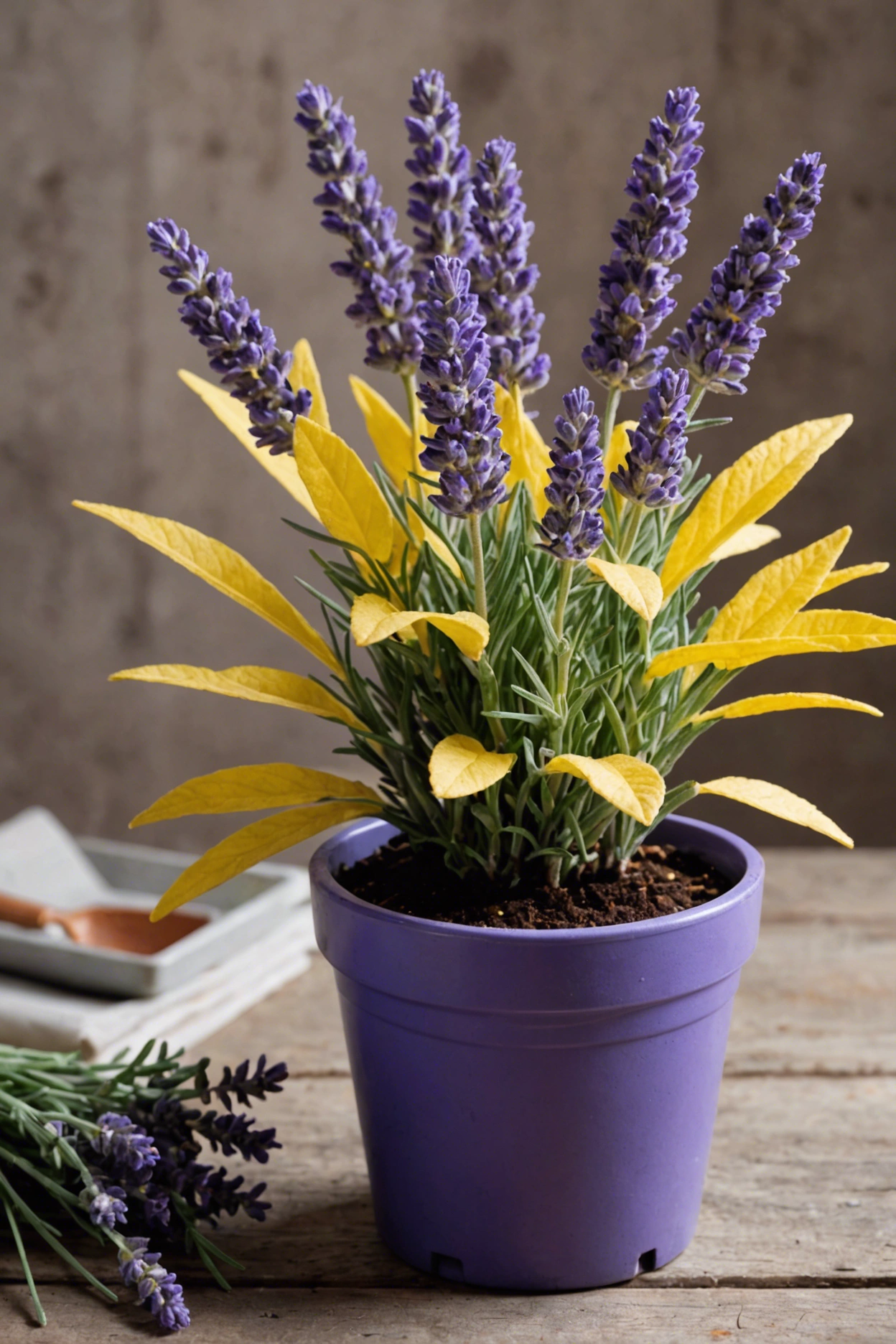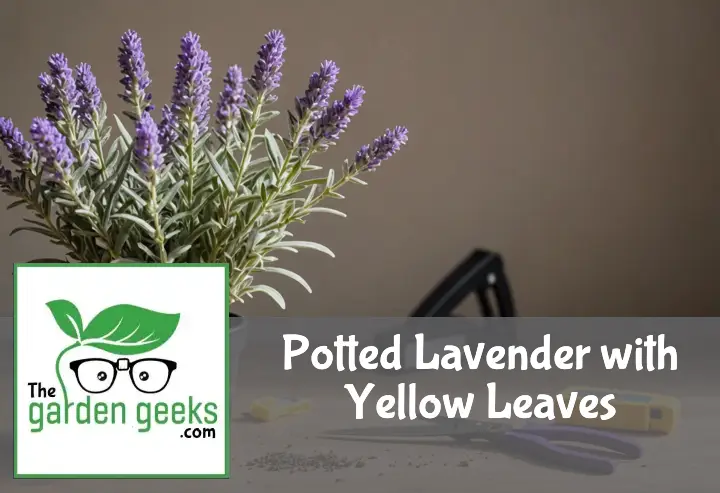Did you know that lavender, the aromatic plant we all love, has over 450 known varieties? Yet, nothing can be more disheartening than seeing your Potted Lavender with Yellow Leaves.
But don’t fret! This common issue is often a sign of an easily fixable problem. From nutrient deficiencies to watering issues, there are several potential culprits behind this worrying sight.
So, let’s dive in and figure out why your lavender leaves might be turning yellow and how to restore their vibrant purple hue. Keep reading about Potted Lavender with Yellow Leaves.
Quick Answer
- Potted Lavender with Yellow Leaves can be caused by nutrient deficiency, overwatering or underwatering, poor soil drainage, light issues, or pest infestation.
- Diagnose the issue through visual inspection for pests and disease, soil testing for nutrient levels, and checking watering patterns and soil moisture.
- Treat yellow leaves by adjusting watering habits, improving soil drainage, providing adequate light, managing pests and supplementing nutrients as needed.
- Prevent future yellowing by maintaining proper care of your lavender plant.

What Causes Yellow Leaves in Potted Lavender?
Yellow leaves on your potted lavender? It’s a sign something’s off. Let’s dig into why this happens.
Nutrient Deficiency
When your potted lavender starts sporting yellow leaves, it might be crying out for nutrients. Think of it like us needing a balanced diet; lavenders need their own mix of food to stay healthy. Nutrient deficiency is often the culprit here. Nitrogen, potassium, and iron are biggies for these plants. If they’re not getting enough, the leaves yell “help!” by turning yellow.
To fix this, you can use a fertilizer made for lavenders or even add compost to give them a boost. Remember, more isn’t always better. Follow the instructions so you don’t end up overfeeding them.
Overwatering or Underwatering
Watering is tricky; too much or too little can send your lavender into a yellow frenzy. Overwatered? The roots can’t breathe, leading to stressed-out, yellow leaves. Underwatered? The plant’s thirsty and showing it through its leaves.
The trick is checking the soil before watering. If it’s damp, wait a bit longer. If dry, it’s time for a drink. Adjusting your watering schedule as seasons change is key since indoor conditions vary throughout the year.
Poor Soil Drainage
Bad news: if your lavender’s soil doesn’t drain well, you might end up with root rot – and yes, yellow leaves are a symptom. Good drainage is crucial for happy lavender roots.
To improve drainage, consider mixing some sand or gravel into your potting mix. Or switch to a pot with better drainage holes at the bottom. This way, water won’t stick around longer than welcome.
Light Issues
Lavenders love light – lots of it! Not enough sunlight can turn their leaves yellow as they strive for more rays. But just like us getting sunburnt, too much direct sun in hot climates can also stress them out.
Aim for that sweet spot of about 6 hours of direct sunlight daily if indoors near a window or under grow lights if natural light isn’t enough.
Pest Infestation
Pests are sneaky little things that can cause big problems like yellow leaves on your lavender plant due to stress and damage from feeding activities.
Common culprits include aphids and spider mites which suck sap from the plants weakening them over time.
Keep an eye out for these pests and use insecticidal soap or neem oil as safe solutions to kick them out without harming your plant.
How to Diagnose Yellow Leaves on Your Lavender Plant
Diagnosing yellow leaves on your lavender plant is crucial. It’s like being a plant detective, looking for clues in the leaves, soil, and water habits.
Visual Inspection for Pests and Disease
When your lavender starts looking more yellow than purple, it’s time for a visual inspection. Think of yourself as a detective with a magnifying glass. You’re on the lookout for tiny bugs or weird spots on the leaves. These are clues that pests or diseases have moved in.
Sometimes, the problem is super tiny insects or funky mold you can barely see. If you spot any, that’s a big hint why your plant might be feeling under the weather.
Other times, it’s about spotting things that just don’t look right. Like parts of the leaf turning colors they shouldn’t be. This step is all about noticing those little changes before they turn into big problems.
Soil Testing for Nutrient Levels
Let’s talk dirt! Soil testing sounds fancy but it’s really just checking if your soil is missing some important food for your plants. Lavenders are like us; they need their vitamins to stay healthy.
If your soil test shows you’re low on goodies like nitrogen or iron, that could be why your lavender’s leaves are turning yellow. It’s like finding out you’ve been eating junk food when what you really needed was some veggies.
Adding the right nutrients back into the soil can be like giving your plant a health shake. Suddenly, it has everything it needs to get back to its vibrant self.
Checking Watering Patterns and Soil Moisture
Watering your lavender is kind of like making pasta; too much water and it gets soggy, not enough and it’s too dry. Finding that perfect amount is key.
If you’re giving your lavender too much love with water, its roots might be drowning. That can make leaves turn yellow because they’re not happy swimming all day.
On the flip side, if you forget about watering and leave the soil dryer than a desert, your lavender will start showing signs of thirst through yellow leaves.
The trick is checking if the soil feels wet or dry before deciding to water again. Imagine sticking your finger into a cake to check if it’s done; that’s how you test your plant’s “thirst level.”



Solutions for Treating Yellow Leaves in Potted Lavender


When your potted lavender starts showing yellow leaves, it’s waving a little flag that says, “Help me!” But don’t worry, you’re about to become a plant superhero. Here are some straightforward steps to bring your lavender back to its vibrant, purple glory.
-
Check the watering schedule: Lavender doesn’t like wet feet. If you’ve been a bit overenthusiastic with the watering can, it’s time to dial it back. Wait until the top inch of soil is dry before giving it another drink. This simple step can often stop the yellowing in its tracks.
-
Ensure proper drainage: Your lavender pot needs to have holes at the bottom. If it doesn’t, consider repotting into one that does or add some gravel at the bottom of the current pot for a quick fix. Good drainage ensures excess water has an escape route, preventing root rot which can cause yellow leaves.
-
Adjust sunlight exposure: Lavender loves sunshine—like, really loves it. Make sure your plant gets at least 6 hours of direct sunlight each day. If your home is more like a cave than a greenhouse, find a sunny spot or consider using a grow light.
-
Feed with care: Over or under-fertilizing can stress your plant out leading to yellow leaves. Use a balanced, slow-release fertilizer designed for potted plants and follow the instructions on the label carefully—less is often more when it comes to feeding lavender.
-
Look out for pests: Tiny critters like aphids and spider mites could be sucking the life out of your lavender’s leaves. Inspect closely and if you spot any freeloaders, gently wash them off with water or use an insecticidal soap as directed.
By following these steps, you’ll not only treat those sad yellow leaves but also prevent future issues from cropping up. Your potted lavender will thank you by flourishing and filling your space with its soothing scent and beautiful blooms.
Preventative Measures to Keep Lavender Healthy
Keeping your potted lavender happy and healthy doesn’t have to be a mystery wrapped in an enigma. It’s all about understanding what this sun-loving, drought-tolerant plant needs (and doesn’t need) to thrive. Let’s break down the simple yet effective ways you can prevent those yellow leaves from ever making an unwelcome appearance.
-
Water wisely: Lavender is like that friend who never wants their drink topped up until it’s completely empty. Overwatering is a big no-no. Make sure the pot has good drainage and let the soil dry out before giving it another drink. This means watering deeply but infrequently.
-
Choose the right spot: These plants love the spotlight – as in, they adore basking in full sunlight for at least six hours a day. If your lavender isn’t getting enough light, it might start throwing a yellow-leafed tantrum. Find a sunny window or consider using grow lights if you’re short on natural light.
-
Mind the soil: Lavender thrives in well-draining soil that’s not too rich. Think of it as preferring a diet of salads over fast food; it likes its environment lean and not overly fertile. You can mix some sand or small gravel into regular potting soil to improve drainage and mimic its natural habitat.
-
Fertilize with care: While feeding your plant might seem like an act of love, lavenders are low-maintenance lovers that require very little fertilizer. If you must feed them, opt for a slow-release, low-nitrogen fertilizer once a year in spring. Too much food can lead to soft, weak growth that’s more prone to disease and yellowing leaves.
-
Prune regularly: Just like getting rid of split ends encourages healthier hair, pruning lavender helps promote vigorous growth and prevents it from becoming woody and sparse at the base. After flowering, give your plant a good haircut, cutting back about one-third of the current year’s growth to keep it bushy and happy.
By sticking to these straightforward steps, you’ll not only avoid yellow leaves but also have a robust lavender plant that smells as good as it looks!
To Wrap Up
We’ve dug deep into the mystery of Potted Lavender with Yellow Leaves. The main culprits are water, light, temperature, soil, and pests. Remember, too much or too little of anything is not good for your lavender.
It’s essential to maintain a balance in caring for your plant. Regularly check its environment and adjust as needed. Keep an eye out for pests and deal with them promptly.
Your potted lavender is counting on you! With careful attention and patience, you can restore its vibrant purple leaves and enjoy its calming aroma once again. Happy gardening!


FAQs about ‘Potted Lavender with Yellow Leaves? (5 Causes and Solutions)’.
Why is my indoor potted lavender turning yellow?
Indoor lavenders can turn yellow due to inadequate light, overwatering, or nutrient deficiency. Ensure your plant gets at least 6 hours of sunlight and has well-draining soil to prevent waterlogging.
Can I save a lavender plant with yellow leaves?
Yes, you can usually save a lavender plant with yellow leaves by identifying and addressing the underlying issue such as improper watering, poor soil drainage, or pest infestation.
How often should I water my potted lavender?
Water your potted lavender when the top inch of the soil is dry. Overwatering can cause root rot which leads to yellow leaves. In general, lavenders prefer drier conditions.
What type of fertilizer is best for my potted lavender?
Lavender plants prefer a balanced fertilizer with equal parts Nitrogen, Phosphorus, and Potassium. They also benefit from occasional applications of lime to maintain an optimal pH level.
Can too much sun make lavender leaves turn yellow?
While lavenders love sunlight, too much intense direct sunlight can scorch the leaves causing them to turn yellow. If your plant receives more than 8 hours of direct sunlight daily, consider providing some shade.
Does repotting help in treating yellow leaves in potted lavender?
Repotting can help if the problem is related to poor soil drainage or if the pot is too small. However, it’s important first to identify the cause of the yellowing before deciding on a solution.


